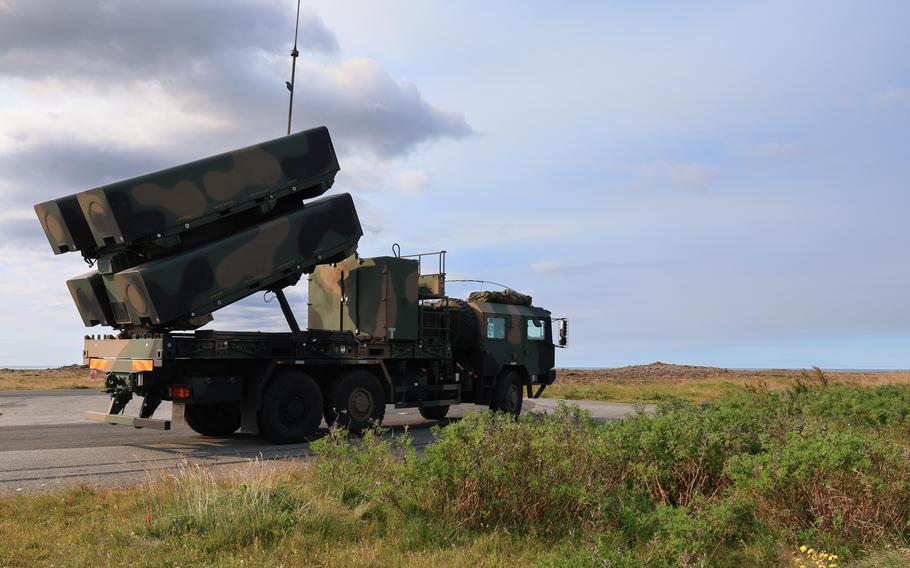
A Naval Strike Missile mobile launch vehicle is in raised firing position during exercise Northern Viking at Keflavik Air Base, Iceland, on Aug. 26, 2024. (Almagissel Schuring/U.S. Navy)
KEFLAVIK AIR BASE, Iceland — The Pentagon’s top general strode to a P-8 Poseidon surveillance plane here on Thursday morning, boarding just before a cold rain turned to snow. The aircraft roared to life and ascended over craggy, black lava fields before heading out over the North Atlantic Ocean. U.S. forces aboard walked him through their mission: surveying the chilly waters for Russian submarines.
The rare visit here by the chairman of the Joint Chiefs of Staff, Gen. Charles “CQ” Brown Jr., came as U.S. forces have observed a rise in Russian submarine activity in the Atlantic. Gen. Christopher Cavoli, the head of U.S. European Command, told the House Armed Services Committee last year that Russian patrols are “at a higher level than we’ve seen in years.”
U.S. and Icelandic officials were reluctant to discuss recent Russian submarine activity, but Brown’s visit underscored that U.S. operations here have evolved because of the war in Ukraine thousands of miles away, U.S. and Icelandic officials said.
Though Iceland has a pacifist tradition and no military, it has been a member of the NATO alliance since its founding after World War II and increasingly has partnered with the United States since Russia’s full-scale invasion of Ukraine in February 2022, hosting a P-8 squadron on a rotational basis and visits by fighter jets and B-2 stealth bombers.
Iceland has pledged to spend 4 billion annually in Icelandic krona, or about $30 million, through 2028 to provide Ukraine with a mixture of military and humanitarian support, and has also signed on to an effort led by the Czech Republic to purchase ammunition for Ukrainian forces.
Brown, speaking to Navy personnel assembled in a hangar just before his flight, said he was scrutinizing Russia’s behavior not only in Ukraine, but as far away as South America.
“We want to be so good at what we do that every day our adversary wakes up and says, ‘Not today,’ ” Brown said. “And if they do say that today is the day, you want to be their worst nightmare.”
Iceland’s foreign minister, Thordis Kolbrun Reykfjord Gylfadottir, said in an interview that her country is ready to bear “more responsibility” in the alliance. Having U.S. forces in Iceland “hasn’t been easy politically through the decades,” she said, but the government needs to “stand on firm ground” and explain to its citizens what it means to be a reliable ally.
“Even though we don’t have a standing army, we definitely have a role to play,” she said. “I wouldn’t say there is a line somewhere in the future on how far we go. It just depends on the developments around us.”
Gylfadottir said that despite Moscow’s focus on the war in Ukraine, Russia maintains significant undersea capabilities in the Arctic: “We have to be vigilant.”
The minister left the door open to larger numbers of U.S. forces deploying to Iceland in the future. “What we ask ourselves is not only does this make Iceland safer and the Icelandic public safer, but also what is our responsibility as the island between Europe and North America?” she said.
U.S. forces were first based in Iceland in 1941, replacing British troops who had landed a year earlier in an effort to prevent the country from falling into Nazi hands. Ten years later, as the Cold War took hold, Washington and Reykjavik signed a bilateral agreement that called for U.S. troops to be based in Keflavik primarily to carry out air defense and maritime surveillance in the North Atlantic.
The arrangement largely held until 2006, when the administration of President George W. Bush, citing threats elsewhere in the world, decided to withdraw all U.S. forces from Iceland. At the time, there were about 1,200 U.S. troops, four fighter jets and a handful of helicopters based there, The Washington Post reported then. The move was decried by Iceland’s ambassador to the United States, Helgi Agustsson, who said the island nation was “deeply disappointed.”
In 2016, the Obama administration signed a new deal with Iceland that allowed “increased rotational deployments as necessary, including but not limited to Anti-Submarine Warfare.” Iceland also agreed to allow the U.S. government to make upgrades to the air base, on the southwest corner of the island. The U.S. Air Force announced several airfield construction projects collectively worth $38 million in 2020, including an expansion of parking aprons and improvements to a cargo pad for handling explosives.
An Icelandic defense official, speaking on the condition of anonymity because of the sensitivity of the issue, noted a silver lining in the abrupt departure of U.S. forces in 2006.
“We had to take over much of the responsibilities very quickly, but I think we learned a lot during that process about what role we can play,” the defense official said. “We have made very significant changes in the last couple of decades since they left.” Perhaps most significant is the Iceland air defense system, a set of four powerful radar sites that each scrutinize hundreds of square miles of airspace.
Russian submarine capabilities have not changed, the Icelandic defense official said, but Russia’s willingness to challenge the norms of warfare has grown. He cited the regular bombing of Ukrainian civilians. “It’s the same government,” he said, “that’s doing that and operating the submarines and planes” in the North Atlantic.